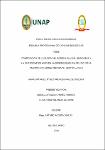Composición de la flora del bosque aluvial inundable y la diversidad de aves en la desembocadura del Río Itaya en época de media creciente, Iquitos – Perú

Date
2024Author
Chávez Ramírez, Mónica Araceli
Valencia Aguirre, Elida Rosa
Metadata
Show full item recordAbstract
Observations of birds and identification of flora of the flooded alluvial forest at the mouth of the Itaya River were made during the period of average flooding, between October 2021 and February 2022, using the methodologies of canoe census, line transects, auditory recognition and counting of plants by plots. The results indicate that the composition of the flora is made up of 60 species distributed in 29 families, including woody trees (Euphorbiaceae, Fabaceae, Myrtaceae, Urticaceae and Vitaceae), shrubs (Malvaceae, Rubiaceae) and floating aquatic plants (Poaceae, Araceae, Cucurbitaceae). A total of 50 bird species were recorded, distributed in 13 Orders and 22 families, with the Passeriformes, Pelacaniformes, Psittaciformes and Accipitriformes being the most abundant and diverse in the area studied. It is concluded that the level of the water that floods the study area conditions the composition of the flora (herbaceous) and the diversity of birds in the flooded alluvial forest, giving way to different strata generated by the cycles of flooding and drainage of the waters of the Itaya River, offering various uses such as feeding, shelter and reproduction sites that are exploited by the birds recorded according to the ecological requirements of the species. Se hicieron observaciones de aves e identificación de flora del bosque aluvial inundable en la desembocadura del río Itaya durante la época de media creciente, entre los meses de octubre de 2021 a febrero de 2022, utilizando las metodologías del censo en canoa, transectos lineales, reconocimiento auditivo y conteo de plantas por parcelas. Los resultados indican que la composición de la flora está conformada por 60 especies distribuidas en 29 familias, entre árboles leñosos (Euphorbiaceae, Fabaceae, Myrtaceae, Urticaceae y Vitaceae), arbustos (Malvaceae, Rubiaceae) y plantas acuáticas flotantes (Poaceae, Araceae, Cucurbitaceae). Se reportan 50 especies de aves registradas, distribuidas en 13 Órdenes y 22 familias, siendo la orden Passeriformes, Pelacaniformes, Psittaciformes y Accipitriformes las más abundantes y diversas de la zona estudiada. Se concluye que el nivel de las aguas que inundan la zona de estudio condiciona la composición de la flora (herbáceas) y la diversidad de aves del bosque aluvial inundable, dando paso a diferentes estratos generados por los ciclos de inundación y drenaje de las aguas del rio Itaya, ofreciendo diversos usos como lugares de alimentación, refugio y reproducción que son aprovechados por las aves registradas según el requerimiento ecológico de la especie.
Collections
- Tesis [422]

